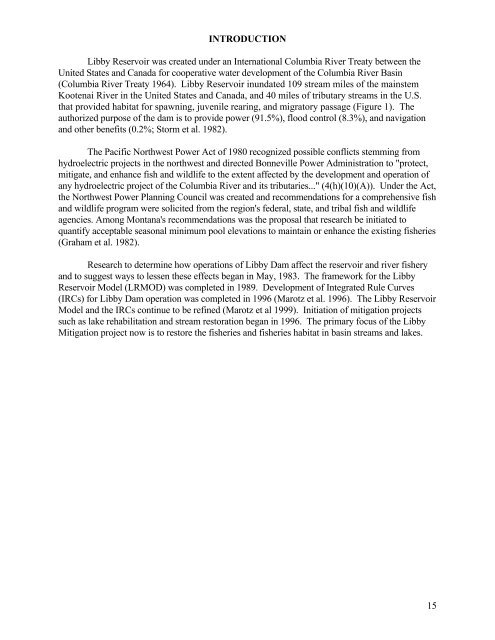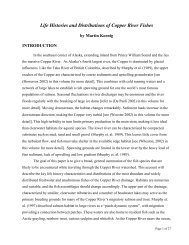Mitigation for the Construction and Operation of Libby Dam
Mitigation for the Construction and Operation of Libby Dam
Mitigation for the Construction and Operation of Libby Dam
You also want an ePaper? Increase the reach of your titles
YUMPU automatically turns print PDFs into web optimized ePapers that Google loves.
INTRODUCTION<br />
<strong>Libby</strong> Reservoir was created under an International Columbia River Treaty between <strong>the</strong><br />
United States <strong>and</strong> Canada <strong>for</strong> cooperative water development <strong>of</strong> <strong>the</strong> Columbia River Basin<br />
(Columbia River Treaty 1964). <strong>Libby</strong> Reservoir inundated 109 stream miles <strong>of</strong> <strong>the</strong> mainstem<br />
Kootenai River in <strong>the</strong> United States <strong>and</strong> Canada, <strong>and</strong> 40 miles <strong>of</strong> tributary streams in <strong>the</strong> U.S.<br />
that provided habitat <strong>for</strong> spawning, juvenile rearing, <strong>and</strong> migratory passage (Figure 1). The<br />
authorized purpose <strong>of</strong> <strong>the</strong> dam is to provide power (91.5%), flood control (8.3%), <strong>and</strong> navigation<br />
<strong>and</strong> o<strong>the</strong>r benefits (0.2%; Storm et al. 1982).<br />
The Pacific Northwest Power Act <strong>of</strong> 1980 recognized possible conflicts stemming from<br />
hydroelectric projects in <strong>the</strong> northwest <strong>and</strong> directed Bonneville Power Administration to "protect,<br />
mitigate, <strong>and</strong> enhance fish <strong>and</strong> wildlife to <strong>the</strong> extent affected by <strong>the</strong> development <strong>and</strong> operation <strong>of</strong><br />
any hydroelectric project <strong>of</strong> <strong>the</strong> Columbia River <strong>and</strong> its tributaries..." (4(h)(10)(A)). Under <strong>the</strong> Act,<br />
<strong>the</strong> Northwest Power Planning Council was created <strong>and</strong> recommendations <strong>for</strong> a comprehensive fish<br />
<strong>and</strong> wildlife program were solicited from <strong>the</strong> region's federal, state, <strong>and</strong> tribal fish <strong>and</strong> wildlife<br />
agencies. Among Montana's recommendations was <strong>the</strong> proposal that research be initiated to<br />
quantify acceptable seasonal minimum pool elevations to maintain or enhance <strong>the</strong> existing fisheries<br />
(Graham et al. 1982).<br />
Research to determine how operations <strong>of</strong> <strong>Libby</strong> <strong>Dam</strong> affect <strong>the</strong> reservoir <strong>and</strong> river fishery<br />
<strong>and</strong> to suggest ways to lessen <strong>the</strong>se effects began in May, 1983. The framework <strong>for</strong> <strong>the</strong> <strong>Libby</strong><br />
Reservoir Model (LRMOD) was completed in 1989. Development <strong>of</strong> Integrated Rule Curves<br />
(IRCs) <strong>for</strong> <strong>Libby</strong> <strong>Dam</strong> operation was completed in 1996 (Marotz et al. 1996). The <strong>Libby</strong> Reservoir<br />
Model <strong>and</strong> <strong>the</strong> IRCs continue to be refined (Marotz et al 1999). Initiation <strong>of</strong> mitigation projects<br />
such as lake rehabilitation <strong>and</strong> stream restoration began in 1996. The primary focus <strong>of</strong> <strong>the</strong> <strong>Libby</strong><br />
<strong>Mitigation</strong> project now is to restore <strong>the</strong> fisheries <strong>and</strong> fisheries habitat in basin streams <strong>and</strong> lakes.<br />
15
















